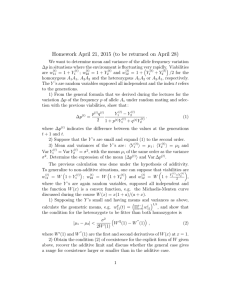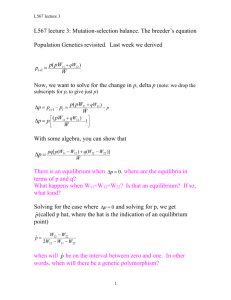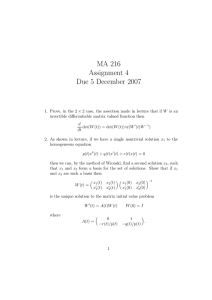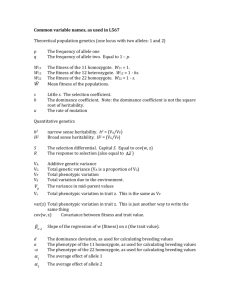MA 216 Assignment 4 Due 5 December 2007
advertisement
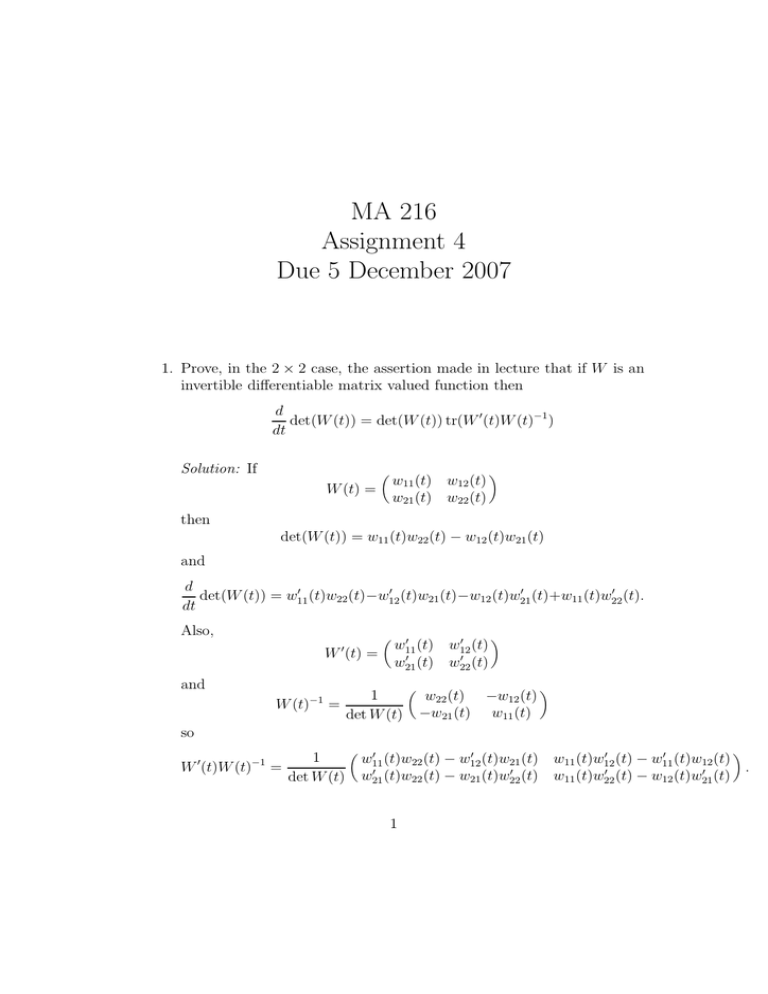
MA 216 Assignment 4 Due 5 December 2007 1. Prove, in the 2 × 2 case, the assertion made in lecture that if W is an invertible differentiable matrix valued function then d det(W (t)) = det(W (t)) tr(W ′ (t)W (t)−1 ) dt Solution: If W (t) = w11 (t) w12 (t) w21 (t) w22 (t) then det(W (t)) = w11 (t)w22 (t) − w12 (t)w21 (t) and d ′ ′ ′ ′ det(W (t)) = w11 (t)w22 (t)−w12 (t)w21 (t)−w12 (t)w21 (t)+w11 (t)w22 (t). dt Also, ′ W (t) = and W (t) −1 ′ ′ w11 (t) w12 (t) ′ ′ w21 (t) w22 (t) 1 = det W (t) so ′ W (t)W (t) −1 1 = det W (t) w22 (t) −w12 (t) −w21 (t) w11 (t) ′ ′ ′ ′ w11 (t)w22 (t) − w12 (t)w21 (t) w11 (t)w12 (t) − w11 (t)w12 (t) . ′ ′ ′ ′ w21 (t)w22 (t) − w21 (t)w22 (t) w11 (t)w22 (t) − w12 (t)w21 (t) 1 2. As shown in lecture, if we have a single nontrivial solution x1 to the homogeneous equation p(t)x′′ (t) + q(t)x′ (t) + r(t)x(t) = 0 then we can, by the method of Wronski, find a second solution x2 , such that x1 and x2 form a basis for the set of solutions. Show that if x1 and x2 are such a basis then W (t) = x1 (t) x2 (t) x′1 (t) x′2 (t) −1 x1 (0) x2 (0) x′1 (0) x′2 (0) is the unique solution to the matrix initial value problem W ′ (t) = A(t)W (t) where A(t) = W (0) = I 0 1 . −r(t)/p(t) −q(t)/p(t) Solution: Differentiate. Substitute. 3. Assuming the result of the previous exercise, find a solution to the inhomogeneous equation p(t)x′′ (t) + q(t)x′ (t) + r(t)x(t) = ϕ(t) in terms of a pair x1 , x2 of solutions to the homogeneous equation p(t)x′′ (t) + q(t)x′ (t) + r(t)x(t) = 0. Hint: The equivalent first order system is x′ (t) y ′ (t) x(t) = A(t) y(t) + 0 . ϕ(t)/p(t) Use the general formula ~x(t) = W (t)~x(0) + Z 0 t W (t)W (s)−1f~(s) ds, for the solution to a first order inhomogeneous system ~x′ (t) = A(t)~x(t) + f~(t). 2 Solution: Substituting, x1 (t) W (t)~x(0) = x′1 (t) x1 (t) = x′1 (t) x2 (t) x1 (0) x2 (0) −1 x(0) x′2 (t) x′1 (0)′ x′2 (0) x′ (0) x(0)x2 (0)−x′ (0)x2 (0) x2 (t) x1 (0)x′2 (0)−x′1 (0)x2 (0) x1 (0)x′ (0)−x′1 (0)x(0) x′2 (t) ′ ′ x1 (0)x2 (0)−x1 (0)x2 (0) and x1 (t) x2 (t) x1 (s) x2 (s) −1 x′1 (t) x′2 (t) x′1 (s) x′2 (s) ′ 1 x1 (t) x2 (t) x2 (s) −x2 (s) = x1 (s)x′2′(s) −′ x′1 (s)x2 (s) x′1 (t) x′2 (t) −x′1 (s) x1 (s) x1 (t)x (s)−x (s)x2 (t) x1 (s)x2 (t)−x1 (t)x2 (s) W (t)W (s)−1 = 2 = 1 x1 (s)x′2 (s)−x′1 (s)x2 (s) x′1 (t)x′2 (s)−x′1 (s)x′2 (t) x1 (s)x′2 (s)−x′1 (s)x2 (s) x1 (s)x′2 (s)−x′1 (s)x2 (s) x1 (s)x′2 (t)−x′1 (t)x2 (s) x1 (s)x′2 (s)−x′1 (s)x2 (s) . Also, Z t ~ ds ( 1 0 ) W (t)W (s)−1 f(s) x(t) = ( 1 0 ) ~x(t) = ( 1 0 ) W (t)~x(0) + 0 x(0)x′2 (0) − x′ (0)x2 (0) x1 (0)x′ (0) − x′1 (0)x(0) = x (t) + x2 (t) 1 x1 (0)x′2 (0) − x′1 (0)x2 (0) x1 (0)x′2 (0) − x′1 (0)x2 (0) Z t x1 (s)x2 (t) − x1 (t)x2 (s) ϕ(s) + ds ′ ′ 0 x1 (s)x2 (s) − x1 (s)x2 (s) p(s) 4. The Chebyshev equation of order n is (1 − t2 )x′′ (t) − tx′ (t) + n2 x(t) = 0. Special solutions are x1 (t) = 1 when n = 0, x1 (t) = t when n = 1 and x1 (t) = 2t2 − 1 when n = 2. In each of these three cases, find the general solution. √ R Hint: You will need to evaluate integrals of the form R(t, 1 − t2 ) dt, 3 where R is a rational function of two variables. Such integrals can always be evaluated in terms of elementary functions by means of the rationalising substution t = 2u/(1 + u2 ) and partial fractions. Solution: In each case 1 s ds = √ 2 1−s 1 − t2 Z t ds √ = 2 x1 (s) 1 − s2 Z w(t) = exp 0 and hence x2 (t) = x1 (t) t Z 0 √ t/(1+ 1−t2 ) 0 2 du . x1 (2u/(1 + u2 ))2 (1 + u2 ) If n = 0 then x1 (t) = 1 and x2 (t) = x1 (t) Z 0 √ t/(1+ 1−t2 ) √ 2 du 1 − t2 ) = arcsin(t) = 2 arctan(t/(1 + 1 + u2 and x2 (t) = 2 arctan(t/(1 + √ If n = 2 then x1 (t) = 2t2 − 1 and √ 1 − t2 ). Z t/(1+ 1−t2 ) x2 (t) (1 + u2 )3 =2 du x1 (t) (u4 − 6u2 +√ 1)2 0 √ √ Z 1 t/(1+ 1−t2 ) 2+ 2 2− 2 √ √ = + 2 2 4 0 √ (u − 1 − 2) √ (u −!1 + 2) 2+ 2 2− 2 √ √ du + + 2 (u + 1 − 2) (u + 1 + 2)2 √ √ " 2+ 2 2− 2 1 √ + √ =− 4 u−1− 2 u−1+ 2 √ √ #u=t/(1+√1−t2 ) 2− 2 2+ 2 √ + √ + u + 1 − 2 u √+ 1 + 2 u=0 #u=t/(1+ 1−t2 ) " 2u(1 − u)2 = 4 u − 6u2 + 1 u=0 √ t 1 − t2 = 2t2 − 1 and hence √ x2 (t) = t 1 − t2 . 4 If n = 1 then x1 (t) = t and we have to be a bit more careful, since x1 (0) = 0. Nevertheless, we still have √ x2 (t) x2 (a) Z t/(1+ 1−t2 ) 1 + u2 = + du x1 (t) x1 (a) 2u√2 a #u=t/(1+ 1−t2 ) " u2 − 1 x2 (a) . + = x1 (a) 2u u=a By choosing the initial conditions for x2 correctly we can arrange that the value at the lower limit cancels the x2 (a)/x1 (a), leaving us with √ x2 (t) 1 − t2 =− x1 (t) t and hence √ x2 (t) = − 1 − t2 . 5
